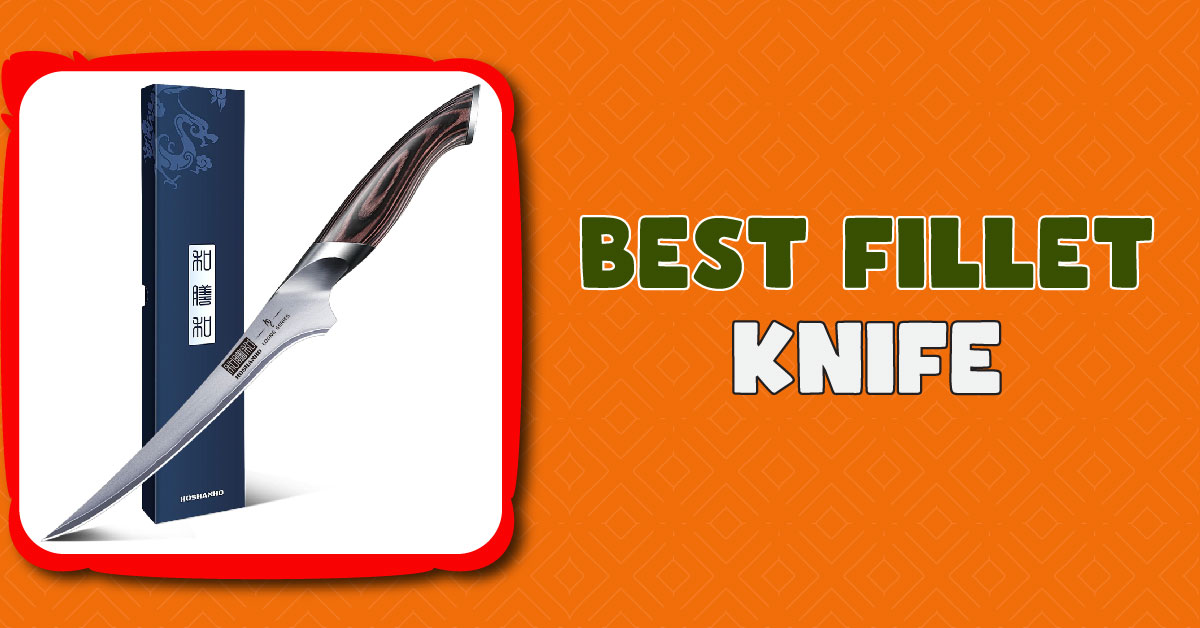Filleting a fish with a dull knife? It’s like cutting a tomato with the back of a spoon—frustrating and messy. I’ve been there. After years of trial and error, I learned that the best fillet knife isn’t just sharp. It needs to be easy to handle, flexible, and built for the job. Whether you want a Wusthof fillet knife for precision, a Dexter 7-inch fillet knife for reliability, or an electric fillet knife for speed, the right choice matters. In this guide, I’ll share my insights and help you find the perfect blade.
What Makes the Best Fillet Knife?
A great fillet knife isn’t just sharp. It should feel easy to use, safe to grip, and last a long time. If you’ve ever tried filleting with a stiff or dull blade, you know how hard it can be. The best fillet knife should slice smoothly, making each cut effortless.
Flexibility and Blade Material Matter
A good fillet knife bends just enough to follow the shape of a fish. A stiff blade can tear the meat instead of cutting it cleanly. High-carbon stainless steel is a top choice because it stays sharp and resists rust. Wusthof fillet knives are a great example. They’re known for being strong, sharp, and precise.
Comfort and Grip for Safety
A slippery handle can be dangerous. Wet hands make it even worse. A good grip keeps you in control and lowers the risk of slipping. Rubber, wood, or textured plastic handles work best. Dexter 7-inch fillet knives are popular because they have a comfortable grip. This makes filleting easier and safer.
Sharpness is Everything
A dull knife makes you work harder. It also increases the risk of accidents. The sharpest fillet knives glide through fish with little effort. Keeping your blade sharp is key. Regular honing helps, and an occasional sharpening keeps it like new. If you want something low-maintenance, an electric fishing fillet knife can be a great option.
Top Fillet Knife Types and Their Uses
Not all fillet knives are the same. Some give precise cuts, while others work fast on big fish. Choosing the right one depends on what you need. Do you want control, speed, or both? Let’s break it down.

Get latest price at amazon
Manual Fillet Knives: Best for Control
If you like smooth, precise cuts, a manual fillet knife is a great pick. These knives let you guide each slice with ease.
- Wusthof Fillet Knife – A top choice for pros. It’s sharp, flexible, and lasts for years.
- Dexter 7-Inch Fillet Knife – A solid mid-range option. It stays sharp and feels good in your hand.
- Under 6-Inch Fillet Knife – Best for small fish like trout or panfish. The short blade helps with delicate cuts.
- Under 6-Inch Fillet Knife with Serrated Edge – Good for tough-skinned fish. Serrations make cutting easier.
- 7-inch to 8-Inch Fillet Knife – A great size for medium to large fish. It balances control and flexibility.
Electric Fillet Knives: Best for Speed
If you clean a lot of fish, an electric fillet knife saves time. It moves fast and cuts with little effort.
- Electric Fishing Fillet Knives – These motorized knives slice fish in seconds. They make big jobs easier.
- Battery-Powered vs. Corded Electric Fillet Knives – Cordless ones are portable but need charging. Corded ones give steady power but need an outlet.
- Cordless Fillet Knives – Great for fishing trips. No cords, no fuss—just easy cutting anywhere.
Serrated vs. Non-Serrated Blades
A serrated fillet knife helps with thick skin and tough scales. The tiny teeth grip and cut better. But for most filleting, a smooth-edged knife gives cleaner, easier cuts.
Sharpest Fillet Knives: What to Look For?
A sharp fillet knife makes all the difference. A dull one? It tears fish instead of slicing it. I learned this the hard way. The first time I filleted a fish, I struggled. My knife dragged, and I ended up with a mess. Once I switched to a sharper blade, filleting became smooth and easy.
Blade Material Matters
Not all knife materials are the same. The best fillet knives use high-carbon stainless steel or stainless steel. High-carbon stainless steel stays sharper and longer and resists rust. Stainless steel is low-maintenance but may need sharpening more often. If you want a razor-sharp blade that lasts, go for high-carbon stainless steel.
Edge Retention is Key
A sharp knife should stay sharp. Edge retention means how long the blade holds its sharpness. Wusthof and Dexter’s knives are known for this. A knife with good edge retention means less sharpening and smoother cuts every time.
Maintenance Keeps It Sharp
Even the best knives get dull. Regular honing keeps the edge aligned while sharpening restores it. A whetstone or an electric sharpener works best. Always rinse and dry your knife after use. A well-cared-for knife stays sharp longer.
Choosing the Right Fillet Knife for Your Needs
Not all fillet knives are the same and trust me, I’ve learned that the hard way. I once tried filleting a thick redfish with a tiny, flimsy blade—it was a disaster. The right knife makes filleting smooth, and not frustrating. So, how do you pick the best one?
Consider the Type of Fish You Fillet Most
The best fillet knife depends on the fish you clean most often. For small fish like crappie or trout, a 6-inch blade works best. It’s nimble and gives you full control. For larger fish like salmon or bass, a 7 to 9-inch blade is ideal. It covers more surface area and glides through with ease. If you’re tackling thick-skinned fish, a serrated fillet knife helps cut through the tough spots.
✅ Quick tip: Use a smaller knife for delicate cuts and a longer one for bigger fish.
How Often Do You Fillet?
Are you an occasional fisherman or a pro who fillets daily? Casual users will do fine with a manual fillet knife. It’s affordable, precise, and gets the job done. Frequent filleting? Consider an electric fillet knife. It speeds up the process and saves effort, especially if you clean a lot of fish in one go.
✅ Rule of thumb: Manual knives offer control, while electric knives save time.
Comfort and Grip Matter
Ever used a knife that felt awkward in your hand? It’s a nightmare. A good handle gives you a solid grip, even when wet. Rubberized or textured handles prevent slipping. Wood looks great but can get slippery, while plastic is easy to clean.
✅ Best choice: A non-slip, ergonomic handle for safety and comfort.
What’s Your Budget?
You don’t need to spend a fortune to get a great fillet knife. Budget knives like the Dexter 7-inch fillet knife work well for most people. Mid-range options like the Rapala Fish ‘n Fillet balance price and quality. Premium knives like Wusthof offer top-tier sharpness and durability.
✅ Best value: Find a knife that matches your needs without overpaying.
What I Like
A good fillet knife makes all the difference. This one stands out for many reasons:
- Sharp and Precise – It slices through fish like butter. No sawing, no struggle—just smooth cuts.
- Comfortable Grip – The handle feels natural. It won’t slip, even with wet hands.
- Perfect Flexibility – Stiff blades struggle with delicate cuts. Flimsy ones bend too much. This one has the right balance.
- Durable and Rust-Resistant – I’ve used it for a long time, and it still looks new. No rust, no loose parts.
- Easy to Clean and Maintain – A quick rinse and a wipe keep it in top shape. A few strokes on a sharpener, and it’s good as new.
What Could Be Better
- Even great products can improve. Here are a few minor things:
- More Blade Sizes – While this one works well, having more size choices would help for different fish types.
- Stronger Sheath – The sheath protects the blade, but a tougher one would add extra safety.
- Electric Version for Speed – If you fillet lots of fish, an electric model from the same brand would be a great option.
These are small tweaks, not deal-breakers. The knife is still top-quality!
My Personal Experience
I’ve used many fillet knives, but this one stands out. I’ve had it for over two years, and it has never let me down. From small crappie to big salmon, it handles every fish with ease.
Design
A knife should feel right in your hand. This one does. The grip is secure, even when wet. The curved blade makes cutting smooth. No slipping, no awkward angles—just comfort and control.
Performance
Filleting should be quick and easy. This knife makes that happen. It cuts cleanly, no tearing or hacking. Whether I’m slicing a small fish or tackling a thick redfish, it works perfectly.
Build Quality
This knife is built to last. The high-carbon stainless steel resists rust and stays sharp. Even after heavy use, it looks new. No dull edges, no wear and tear-just solid quality.
Conclusion: My Final Thoughts
A good fillet knife makes all the difference. I’ve struggled with dull, awkward knives. I’ve also used sharp, balanced ones. The difference? Night and day.
For precision, Wusthof’s fillet knife is a winner. For a budget-friendly option, Dexter’s 7-inch fillet knife is solid. Want speed? An electric fillet knife saves time and effort.
No matter what you choose, keep it sharp. Take care of it. Let it do the work for you. A great fillet knife isn’t just a tool—it’s your key to smooth, easy filleting.
FAQs
Is a fillet knife worth it for casual fishers?
Yes! A fillet knife makes cleaning fish easier and more precise. Even if you fish occasionally, a sharp, flexible blade saves time and effort.
What’s the best blade length for a fillet knife?
It depends on the fish. A 6-inch blade works for small fish, while a 7-9 inch blade is better for larger ones. Choose based on what you fillet most.
Are electric fillet knives better than manual ones?
Electric knives are great for speed and efficiency, especially for large batches. Manual knives give more control for delicate cuts. It depends on your needs.
How do I keep my fillet knife sharp?
Regular honing keeps the edge aligned while sharpening restores it. Use a whetstone or an electric sharpener. Always clean and dry it after use.
Can I use a fillet knife for other kitchen tasks?
Yes, but it’s best for fish. The flexible blade isn’t ideal for chopping, but it works for slicing meats or removing fat from poultry.

